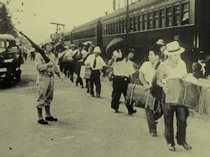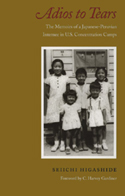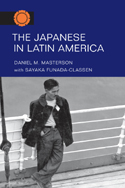

Panama Canal Zone: Japanese Peruvians en route to U.S. Internment Camps. April 2, 1942. U.S. Army Signal Corps Photo. National Archives. Courtesy of National Japanese American Historical Society.
CFJ Brochure – English,
Japanese, Spanish
Bibliography
FAQ
Commission Bill
Books
Videos
Photo Gallery
Exhibits
Media Room
Speeches
Archives
Litigation Archives
Newsletters
Past Events
| Join Our Mailing List |
Campaign for Justice
P.O. Box 1384
El Cerrito, CA 94530
(510) 528-7288
info@campaignforjusticejla.org
|
RESOURCES
Memoirs of a Japanese-Peruvian
Internee in U.S. Concentration Camps Seiichi Higashide Adios to Tears is the very personal story of Seiichi Higashide (1909-97), whose life in three countries was shaped by a bizarre and little-known episode in the history of world War II. Born in Hokkaido, Higashide emigrated to Peru in 1931. By the late 1930s he was a shopkeeper and community leader in the provincial town of Ica, but following the outbreak of World War II, he—along with other Japanese Latin Americans—was seized by police and forcibly deported to the United States. The Japanese Latin Americans were part of a hostage exchange program for white Americans held in Japan. He was interned behind barbed wire at the Immigration and Naturalization Service internment camp in Crystal City, Texas, for more than two years. After his release, Higashide was able to remain in the U.S. and eventually became a citizen. For years, he was a leader in the effort to obtain redress from the American government for the violation of the human rights of the Japanese Peruvian internees. Higashide’s moving memoir was translated from Japanese into English through the efforts of his eight children, and was first published in 1993. This second edition includes a new Foreword by C. Harvey Gardiner, professor emeritus of history at Southern Illinois University and author of Pawns in a Triangle of Hate: The Peruvian Japanese and the United States; a new Epilogue by Julie Small, former co-chair of Campaign for Justice—Redress Now for Japanese Latin Americans; and a new Preface by Elsa H. Kudo, eldest daughter of Seiichi Higashide. “What tears must have been shed by this former hostage of America in writing this heart-wrenching masterpiece. Readers will be inspired, enthralled, and will end up caring deeply.” Michi Nishiura Weglyn, author of Years of Infamy: The Untold Story of America’s Concentration Camps
A volume in the series The Asian American Experience, edited by Roger Daniels. Daniel M. Masterson with Sayaka Funada-Classen Japanese migration to Latin America began in the late nineteenth century, and today the continent is home to 1.5 million persons of Japanese descent. Combining detailed scholarship with rich personal histories, The Japanese in Latin America is the first comprehensive study of the patterns of Japanese migration on the continent as a whole. When the United States and Canada tightened their immigration restrictions in 1907, Japanese contract laborers began to travel to Latin America to work in mines and on plantations. Daniel M. Masterson, with the assistance of Sayaka Funada-Classen, examines Japanese agricultural colonies in Latin America as well as the subsequent cultural networks that sprang up within and among them, and the changes that occurred as the Japanese moved form wage labor to ownership of farms and small businesses. Masterson also explores recent economic crises in Brazil, Argentina, and Peru that combined with a strong Japanese economy to cause at least a quarter million Latin American Japanese to migrate back to Japan. Illuminating authoritative research with extensive interviews with migrants and their families, The Japanese in Latin America examine the dilemma of immigrants who maintained strong allegiances to their Japanese roots even as they struggled to build lives in their new countries.
|
HOME | WHO WE ARE | WHAT WE DO | GET INVOLVED
RESOURCES | HISTORY | MEDIA ROOM | LINKS
Contact: Campaign for Justice

